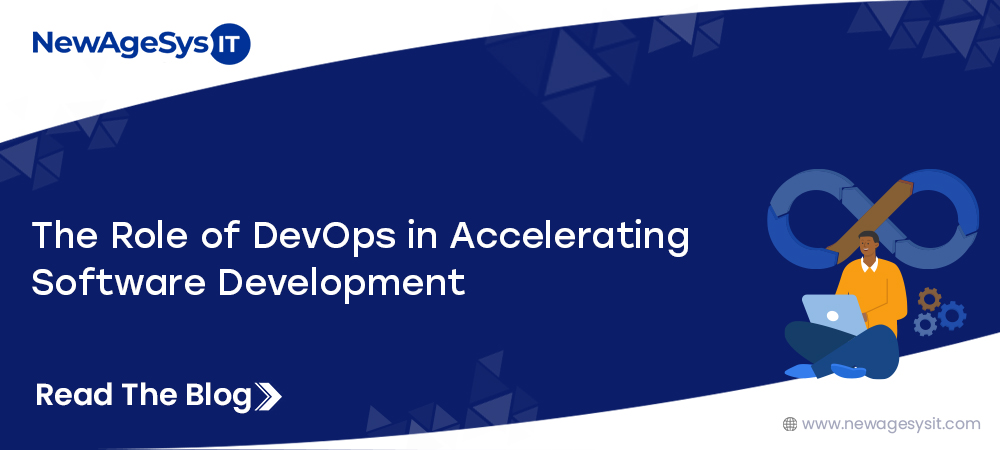DevOps software development now moves at a pace wherein staying flexible and efficient can make or break you. DevOps has proven to be a groundbreaking methodology that has dissolved the traditional barriers between development and operations. It accelerates the software delivery process, ensuring high standards of reliability and adaptability.
The impact of DevOps is spreading, fundamentally altering how businesses manage software initiatives. It boosts productivity, removes obstacles, and enhances the flexibility of the software development cycle.
From piecing together code to rolling it out, DevOps centers on automation to make sure software is built quickly and doesn’t miss a beat. Next, we’ll take an in-depth look at the foundations of DevOps and how it’s reshaping software development services.
Overview of DevOps in Software Development
DevOps is where “Development” meets “Operations,” breaking old patterns to dissolve traditional barriers and promote continuous learning. The idea is to merge development and IT practices, transforming the organizational mindset to create software faster and with better results.
DevOps helps streamline development cycles, allowing for quicker feature releases, regular fixes, and updates that are closely tied to business goals in partnership with your software development team.
The Six Essential Pillars Holding Up DevOps in Software Development
Continuous Integration (CI)
In DevOps, Continuous Integration (CI) means regularly combining code changes from different developers into a shared system, often several times a day. This process is automated, making it easier to catch and fix errors early, which saves time and prevents bigger problems later.Keeping the codebase ready to deploy at all times, CI improves the software development New Jersey, enabling teams to roll out features and fixes faster and with more confidence.
Continuous Deployment (CD)
By automating software releases to production, Continuous Deployment turns CI into a smooth, hands-off process. As soon as changes pass automated checks, they’re deployed, shrinking the timeline from coding to user access. Through CD, companies build a culture of speed and adaptability. It results in the development of innovative apps that keep up with customers’ ever-changing preferences.
Infrastructure as Code (IaC)
Infrastructure as Code allows teams to set up and manage computing environments using code, making it easier to automate tasks and avoid manual work. Stick to this technique, and you’ll see how it keeps infrastructure setups predictable, smooth, and free from common human blunders. Companies using IaC can easily scale up or down, adapting to user demands while ensuring their applications stay reliable and high-performing.
Automation
With automation as its backbone, DevOps eliminates redundancies in testing, deployment, and infrastructure management. Delegating these tasks to automation enables teams to focus on creating standout features and a user-friendly experience. Automation doesn’t just save time—it ensures every step is consistent and reliable, enabling quicker, more assured software releases.
Collaboration and Communication
Breaking down barriers between dev and ops starts with strong collaboration and clear communication. When a DevOps culture prioritizes open communication and teamwork, it leads to better clarity around goals and evenly distributed responsibilities. When teams operate in sync, they communicate better, share knowledge freely, and handle obstacles efficiently, leading to project success and higher productivity.
Monitoring and Feedback
Monitoring applications and gathering feedback are the twin pillars of DevOps, offering a roadmap to better performance and satisfaction. By consistently reviewing how systems function and collecting user insights, teams can pinpoint areas that need tweaking and take smarter actions. Through ongoing tweaks, this method keeps software valuable and adaptable, enabling businesses to handle changing demands and industry shifts with ease.
What’s the Big Deal About DevOps in the Software World?
Accelerated Time-to-Market
A major perk of DevOps software development is how it shortens the path from development to delivery, enabling businesses to respond swiftly to customer needs. By setting up automation for processes like integration and deployment, teams can work smarter, not harder, and push products from code to production much faster. Software development companies in New Jersey that embrace DevOps can ditch their quarterly releases in favor of deploying updates as often as daily, staying ahead of competitors and on top of opportunities.
Improved Quality and Reliability
DevOps practices deliver exceptional reliability by focusing on testing automation and keeping a constant pulse on the system throughout development. Testing integrated into the CI/CD process catches bugs earlier, helping teams avoid the headache of flawed deployments. Addressing problems early not only results in better products but also improves the consistency of applications. A software development company might adopt automatic testing routines that regularly review code, reducing future glitches and boosting customer happiness.
Enhanced Customer Satisfaction
One of the standout benefits of DevOps is how it increases customer satisfaction by fostering faster and more responsive development cycles. Organizations that value flexibility and collaboration between teams can easily evolve with customer needs. Rolling out updates that align with user needs ensures satisfaction and keeps customers coming back for more. With feedback loops enabled by DevOps, software companies can bridge the gap between customer expectations and actual product performance, enriching the user experience.
Increased Efficiency
DevOps software development enhances productivity by eliminating isolated work environments and encouraging teams to collaborate more effectively. Addressing these hurdles enables organizations to create efficient workflows and tackle challenges faster, leading to higher productivity levels. When automation handles routine tasks, it reduces mistakes and lets teams focus on more important work. For example, software development teams can use infrastructure-as-code tools to set up servers automatically, saving a lot of time and effort.
Cost Reduction
DevOps ensures resources aren’t wasted, helping companies save money without cutting corners. When companies automate tasks and emphasize teamwork, they can cut the costs of developing and maintaining software. Using continuous integration makes deployments smoother and reduces errors, saving time and money on fixing bugs later. By adopting DevOps practices, software firms can save money by simplifying processes and minimizing downtime, creating a more cost-efficient way to operate.
Encourage Continuous Learning and Improvement
At its heart, DevOps is all about continuous learning and improvement, creating a culture that encourages creativity and innovation within organizations. By making feedback and trial runs a priority, teams can improve how they work and what they deliver. Looking back on previous deployments during retrospectives and attending training sessions helps teams improve their overall performance and quality management. To remain relevant in the tech race, software development companies invest heavily in continuous learning and staying on top of emerging trends.
Enhance Software System Scalability and Stability
DevOps allows companies to balance scalability and reliability, making it easier to keep up with shifting workloads. To handle busy times without a hitch, teams rely on methods like scaling resources dynamically and organizing containers smartly. A software development company can depend on cloud computing to dynamically manage traffic, keeping user experiences smooth during busy times. This feature helps keep things running smoothly, making users feel more confident and happier with the services they’re using.
Enhance Collaboration and Communication
Strengthening collaboration and streamlining communication are core features of DevOps that completely change team interactions. Encouraging open conversations and mutual accountability helps teams solve problems faster and make their processes run like clockwork. Collaboration tools like Slack and Jira make it easy to share updates and give feedback instantly, keeping everyone on the same page about project goals. Adopting these strategies helps software development firms not just achieve better project success but also strengthen team relationships, boosting motivation and engagement across the board.
The Step-by-Step Evolution of Software Development Through DevOps
Step #1 – Planning
The planning stage of the DevOps lifecycle is the backbone of the entire project, where the goals, boundaries, and needs are clearly laid out. Important individuals unite at this stage to establish a joint vision that shapes the course of development. Unlike older strategies, DevOps keeps evolving by learning from what worked before and anticipating what’s ahead to improve project outcomes. Working together like this keeps everyone in sync, clears up confusion, and sparks fresh ideas while driving strategies that look ahead.
Step #2 – Development
During development, programmers bring the agreed-upon specifications from the planning stage to life through code. The code must meet both functional and operational needs, highlighting the importance of teamwork between development and operations. The main idea of continuous integration is to test and merge code changes frequently, keeping everything up to date. With each coding cycle, the quality improves, features are delivered faster, and teams stay ahead of shifting requirements, keeping stakeholders updated efficiently.
Step #3 – Quality Assurance
The role of QA in DevOps is evolving, replacing old-school testing techniques with smarter, automated solutions. At this point, testing happens continuously as part of development, making it easier to catch and solve issues early on. Automated testing tools help achieve full test coverage by checking every code change before it goes live. Fixing issues before they arise ensures fewer frustrations and a higher-quality product that people can rely on every time.
Step #4 – Deployment
It’s in the deployment phase that the completed code finally steps into the production environment. When it comes to DevOps, deployment isn’t just the operations crew’s job. It’s a group project with developers and operations both pulling their weight. By automating releases, continuous deployment minimizes downtime and ensures new features and updates reach users more often. During this phase, configuration tools are typically used to ensure the deployment process goes off without a hitch and resolve any potential compatibility issues.
Step #5 – Monitoring
Keeping an eye on things during the DevOps lifecycle is a continuous effort, especially once the software is live and running. In this phase, the goal is to track the app’s performance, understand user experiences, and ensure everything’s running smoothly while looking for any tweaks that can help. Real-time monitoring tools offer instant insights into how systems are performing, making it easier for teams to address problems and enhance functionality. The findings at this point are a cornerstone for planning updates, helping the development stay flexible and driven by user insights.
Technologies and Tools Shaping the DevOps Ecosystem
Jenkins
As an open-source automation server, Jenkins transforms the way software teams handle CI/CD processes, making them faster and more efficient.
Prometheus
Designed for DevOps teams, Prometheus is an open-source toolkit offering live system monitoring and alerting, making problem detection and resource management easy.
Ansible
With Ansible, IT professionals have an open-source ally to handle repetitive chores, streamline setups, and deploy apps effortlessly.
Kubernetes or K8s
This open-source platform is the go-to solution for automating container workflows, making DevOps pipelines more efficient and resilient.
Docker
Docker helps developers wrap their apps into lightweight containers, making it simpler to distribute and run them across different environments without headaches
Git
In the DevOps space, Git allows developers to manage code changes easily and collaborate effectively, with everyone having their own copy of the project.
Final Words…
When DevOps strategies are adopted, they make software development faster by encouraging teamwork and open communication between dev and ops teams. Collaborating this way ensures deployments are quicker and more efficient, with software quality enhanced by ongoing integration and automated testing.
Organizations that embrace flexible and cooperative work cultures can rapidly adapt to change, leading to quicker innovation and a more competitive standing. By cutting through unnecessary steps and encouraging collaboration, DevOps lets teams deliver faster and work smarter in the fast-paced software industry.
Turn to NewAgeSysIT for a stress-free experience in software and social media app development, backed by their DevOps solutions. Combining vast expertise with a passion for quality, NewAgeSysIT uses agile frameworks and automation tools to streamline collaboration within teams. Our delivery cycles are fast and efficient, with quality never taking a backseat to speed.
Known for their skilled professionals in cloud and configuration technologies, NewAgeSysIT leads the way in optimizing software lifecycles and driving business success. Need more details about what we offer in DevOps software development? Get in touch with us today!










